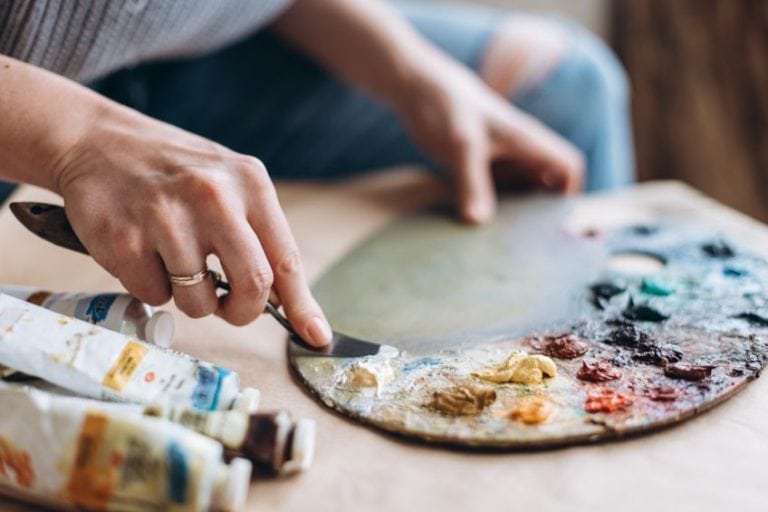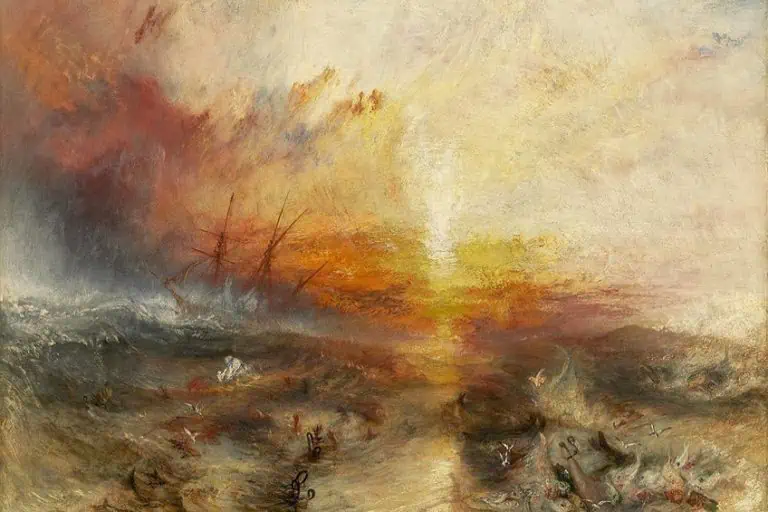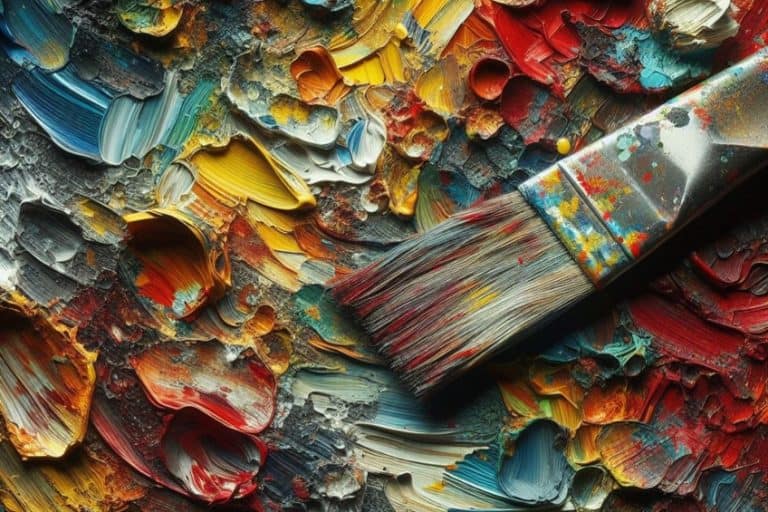Acrylic Paint on Glass – Painting Glass with Acylics
This post may contain affiliate links. We may earn a small commission from purchases made through them, at no additional cost to you.
A major appeal for working with acrylic paint is its versatility This art medium can be used over a wide variety of surfaces – including glass. Thanks to their thick consistency, these paints are easy to work with and can adhere to even the smoothest surfaces. Interested in painting on glass with acrylics? These paints are easy to work with and will produce amazing results when done properly. This article will explore the concept of acrylic paint on glass, and how these two mediums can be used together.
Table of Contents
- 1 Can You Use Acrylic Paints on Glass?
- 2 Painting Glass With Acrylic Paint
- 3 Choosing the Right Acrylic Paint
- 4 Acrylic Paint on Glass – Which Paints Are Best
- 5 Finding the Right Paintbrush
- 6 Which Glass is Best to Paint On?
- 7 Materials Required for Acrylic Paint on Glass
- 8 Painting on Glass With Acrylics – Tutorial
- 9 How to Seal Acrylic Paint on Glass
- 10 Painting on Glass with Acrylics: The Best Sealer
- 11 How to Bake Acrylic Paint on Glass
- 12 Frequently Asked Questions
Can You Use Acrylic Paints on Glass?
Acrylic paints are suitable for a very wide range of surfaces and materials – including glass. When applying acrylic paint on glass, enamel paint is best as they are durable and adhere well to smooth surfaces. Even though these paints will work well with glass, the glass will still need to be properly p[repared for painting. Make sure that there is no dirt, dust, or oils on the glass. You can also add a layer of primer to make sure that the acrylic paint on glass adheres strongly. You can also protect the paint with a sealant or varnish to help to prolong its lifespan.
As a painting medium, acrylics are water-resistant, durable, versatile, easy to clean up, and not very toxic. This makes this type of paint an attractive choice for beginners through to experienced artists, no matter what type of mediums you are using.
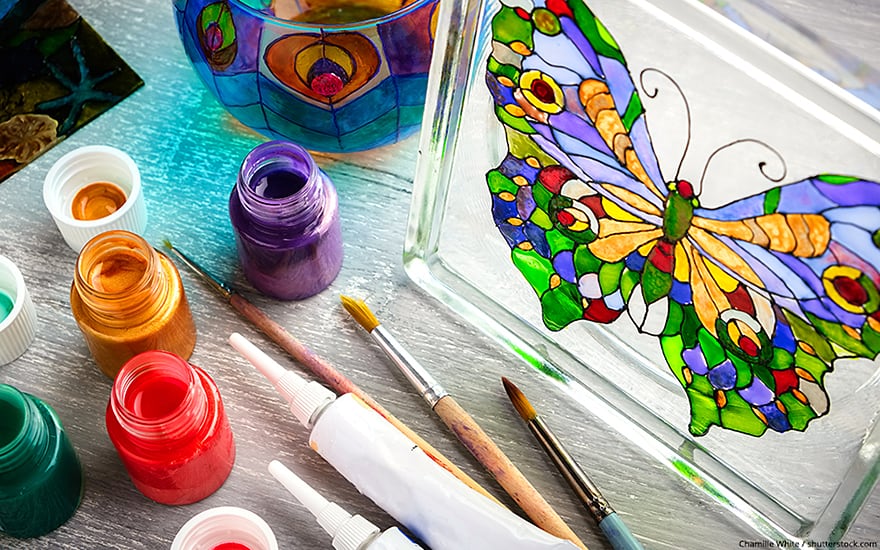
Painting Glass With Acrylic Paint
The big question to ask is: will acrylic paint stick to glass? Yes, acrylic paint can be used over glass. However, this doesn’t mean that it will always stick easily. For best results, a primer should be used over the smooth glass surface. This should be an enamel-based primer if using an enamel-based paint. To apply the primer, you can either use a brush or a sprayer. Let this layer dry fully for 24 to 72 hours before painting over. The primer will create a more rough surface which will help the paint to stick tightly onto the glass. Some acrylic paints are specially formulated for use on glass and won’t necessarily need a primer. Using a primer is generally a good idea though to increase the paint adhesion.
Choosing the Right Acrylic Paint
Not all acrylic paints are made equal. When choosing the right acrylic paint for painting over glass, consider your various requirements and needs for the project. Do you need a permanent solution or one that can wash off? If creating glass artwork, you will want to choose a paint that is as long-lasting as possible. Enamel-based acrylic paints are generally the preferred choice here as they are durable and have many different effects and finish options available. If you are asking the question, “can you use acrylic paints on glass?”, there are always a few considerations to make when choosing the perfect paint for your needs.
Transparency
The opacity or transparency of the paint is an important buying factor. This refers to how solid the color is, which is something that will affect the overall brightness. For glass, this is particularly important. Opaque colors will block out any light, and transparent ones will let the light shine through. The style you choose is a matter of personal taste.
Lightfastness
When paints are exposed to sunlight, the colors can sometimes fad away. This is what lightfastness refers to. A lightfast paint will maintain its pigment and will offer resistance to UV rays and fading. When painting over glass that is exposed to light, this is an important consideration.
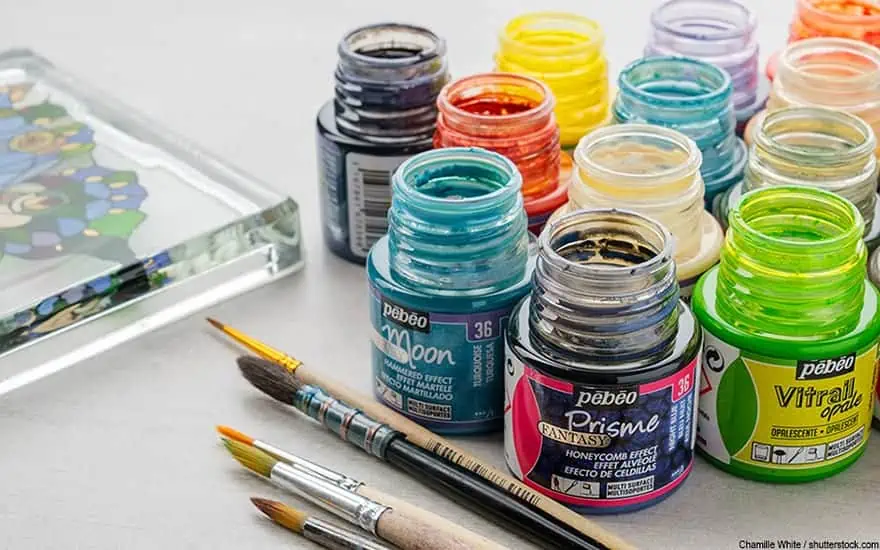
Consistency
Whichever paints you use will need to have a similar consistency. Never mix together two paints of different consistencies, as this will result in an inconsistent painting. Test how thin or thick paint is by comparing small amounts of each next to each other. Also know that when the paint dries, paints with different consistencies produce different effects. When painting on glass, you don’t want to use paint that is too thin.
Finish
When the paint has finished drying it will have a unique finish. You can choose between various paint finishes to achieve your ideal final look. This includes glossy, matte, and frosted. This choice depends on the overall look and feels that you are trying to achieve. Many artists like to use a frosted finish over the glass, as glossy finishes can become quite reflective.
- Glossy enamel acrylic paints can be used for an opaque finish or a thick coat
- Frosted paints have a lighter and thinner coat
- There is also a crystal gloss enamel paint that can be used to provide a combination between glossy and frosted
- If you want to achieve a finish that is completely matte and opaque, you can use a gesso and acrylic paint combination. If painted onto a flat piece of glass, this combination will actually look like a canvas
- Glass liner and water-based acrylics can be used for stained glass painting. Alternatively, you can use special glass paints to achieve this effect
Acrylic Paint on Glass – Which Paints Are Best
Glass is not your typical surface to paint on, and it really needs quality paint to be able to come through well. If you plan on painting glass with acrylic paint, we have picked out some of the top product choices for you to choose from below.
Overall Best: FOLKART Acrylic Craft Paint Set
This set of acrylic paints by CraftArt is ideal for painting over glass thanks to its satin finish. The set includes 12 paints in a useful variety of colors. While these paints are perfect for glass, they can also be used over the canvas, wood, fabric, ceramic, paper, and all kinds of other surfaces. The paints are completely safe to use thanks to their non-toxic properties. Their water-base makes them convenient for cleaning up and using by all. The FolkArt acrylic paint set can be used indoors or outdoors thanks to its versatile durability. You get bright colors and quality pigments in this set.
- Premium quality paint for almost any surface, like wood, glass, fabric, and more
- Perfect for brush painting and detailing, sponging, stenciling and stamping
- Can be used on indoor and outdoor projects. Water-based, non-toxic, made in the USA
PROS
- Very high-quality paints
- You get a wide range of bold colors
- The paints can be used on many different surfaces
- Water-based paints that are non-toxic and safe
CONS
- Very fast to dry
- Not lightfast paints, so not the best option for outdoor use
- The paints are very thick. If you want a thinner consistency you may need to add a paint thinner
Premium Acrylic Paint Choice: ARTEZA Outdoor Acrylic Paint Set
This big 20 pack set of acrylic paints by Arteza features some beautifully rich and vibrant colors. The paints are created with a high pigment content which offers a rich and smooth finish that lasts a long time. When it comes to acrylic paint on glass options, these paints are a luxurious option. They have a high viscosity which helps to make them more long-lasting once dried. This set of acrylics is suitable for indoor or outdoor use. The paints have good durability, and are self-sealing, scuff-resistant, and adhere well to many different surfaces. The paints are water-based for convenient use and have a non-toxic formulation.
- Features smooth, highly pigmented colors that produce true, consistent shades
- You can be confident that these colors won’t fade over time, perfect for Indoor and Outdoor Use
- Certified Safe and Non-Toxic – they’re ACMI-certified
PROS
- You get a wide range of rich colors in this set
- These acrylic paints are suitable for use on a wide range of different surfaces
- Certified non-toxic
- Suitable for indoor and outdoor use
- Durable and resistant paint
CONS
- A very thick paint that may require thinning for certain uses
- Other acrylic paints offer better coverage
Best Budget Acrylic Paints: INDIVIDUALL Premium Acrylic Paint Set
Even though this is our most budget-friendly acrylic paint set choice, you still get paints of a superior quality to most. These paints are of a professional-grade, producing vivid colors and wonderfully smooth consistency. These are highly pigmented paints that stretch pretty far. Diluting them works well, where the colors are still maintained. This is a slightly smaller set with eight different colors included. However, these colors mix and blend together easily, and are able to create absolutely any type of color shade you can imagine. The paints are also formulated to be durable and long-lasting, allowing the artwork to stay bright and vibrant over the years.
- Features extremely high pigmentation, giving each painting a smooth consistency
- This acrylic paint kit comes with 8 bright and beautifully vivid colors
- Great for painting indoors and outdoors, and also stick to variety of surfaces
PROS
- Very highly pigmented paints
- Bold and vibrant colors
- A very user-friendly paint
- This acrylic paint is suitable for most types of surfaces, including glass
CONS
- The paint set has a pretty small selection of colors
Finding the Right Paintbrush
You may have the best acrylic paint available, but without the right paintbrush, it is useless. When using acrylics to paint on glass, there are a number of brush styles you can choose from. Each one offers its own unique painting style. We have outlined a few top paintbrush tips below:
- Synthetic bristle brushes are not the first choice, because they can leave brush marks in the paint. However, if you are trying to achieve a more rustic look then this could work in your favor. Synthetic brushes are a good choice for doing smaller, more detailed bits of painting.
- Natural bristle brushes offer a smoother finish that is more even. This is a great option for base coats and broad color blocks.
- Some artists like to use sponges, as they can create a special kind of textured appearance over the glass. This look is evenly coated and slightly frosty looking.
- Choosing the right size of the paintbrush is also essential. The size and shape of the brush will determine what kind of effects you will create, and how detailed you can paint. Go for a flat and wide brush for applying basecoats and a smaller pointier brush for finer details.
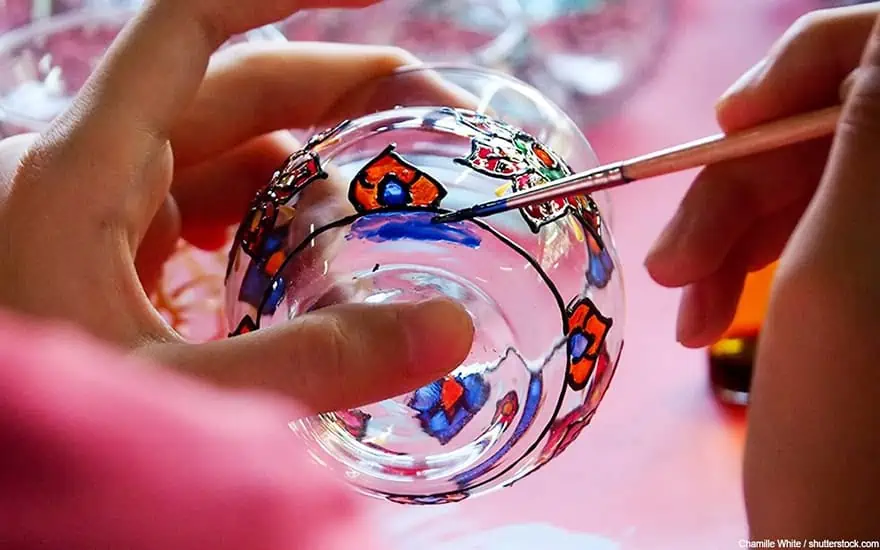
Which Glass is Best to Paint On?
Each different piece of glass has its own coefficient of expansion (COE). This is how much the glass expands and contracts when heating and cooling. This is a really important consideration for painting glass with acrylic paint, as the paint will need to have enough flexibility not to crack when this happens. If you are baking the glass piece, this is particularly important. Thick glass may be stronger, but thinner glass is more flexible. The most flexible glass with great COE is the type of glass used in dinnerware. Thick glass, like the kind used in bakeware, is not very flexible so it might crack while expanding.
Although thin glass is flexible, it is also sensitive to temperature changes. Painting on glass with acrylics at home is best done on smaller glass items, as bigger pieces will need to be baked in a professional kiln.
Materials Required for Acrylic Paint on Glass
When applying acrylic paint on glass, a couple of different materials should be used for achieving great results. The list of equipment includes:
- The piece of glass to paint on. This could be a flat glass plane, a piece of glassware, or a decorative glass item
- Rubbing alcohol for making sure the glass surface is properly clean. This can be applied with cotton balls or a paper towel
- A range of different paintbrushes are good to have for achieving various effects and levels of detail
- A paint palette for mixing the paint on
- A design, stencil, or pattern if you are using one as a template
- The acrylic paints. Try to use enamel or glass paints as these are formulated for use on smooth surfaces like glass. They offer a durable finish and great coloring
- Acrylic medium. If you need to thin down the paint’s consistency a bit, use a clear acrylic medium. We do not recommend using water for this because glass is not porous
- A glass outliner if you want to achieve a stained glass effect
- Glass paint markers for small details or for writing with
- You may also want to use a sealant or varnish. This makes them last longer and protects the paint. If your painted glass is being used with food, make sure that the sealer is labeled as being food safe
Painting on Glass With Acrylics – Tutorial
When painting acrylic paint on glass, there are a number of different methods you could take. You could paint freehand, or follow a stencil design. All you really need are brushes and some sponges to turn your vision into amazing artwork. We have highlighted some directions and tips below for creating your first glass painting.
Preparing the Glass
Wondering how will acrylic paint stick to glass? Well, first the glass surface needs to be prepared. Glass is very smooth, so the paint will; need a suitable surface to adhere to. When preparing the glass, start by washing it completely in soapy water. Wait for the glass to air dry. When dry, wear latex gloves to make sure you don’t leave any marks or fingerprints on the glass. Wipe down the entire glass surface with rubbing alcohol or vinegar and let it air dry again.
If you are painting a drinking glass, then tape off the edges that you will drink from. Having paint over areas where you drink can cause the paint to chip away faster. If there are any other places that you don’t want to be painted, then tape over these too. Then coat a base coat over the entire glass with a wide brush. You can add gesso as the base coat for glass surfaces that you want to achieve an opaque effect over. If you will not be painting the glass surface completely, and just want to add some design flourishes, then skip this step of adding a base coat.
Make sure that the base coat is completely dry before adding any more layers of paint. This should be left for at least an hour. You don’t want the second layer of paint to blend into the first coat.
Painting Glass With Acrylic Paint
The glass is now properly cleaned, primed, and ready for painting. Now you can start to apply your design. It’s a good idea to draw out the design on paper first. This can be traced onto the glass for greater accuracy. Make sure that the paints you will be using are prepared, mixed, and ready to go. You can trace the outline of the design with a marker over the glass surface. This can be done by sticking the stencil on the inside of the glass, as long as the glass is still clear and doesn’t have a base coat. This technique is also used for applying liners. Don’t worry about getting marker lines perfect. Any unwanted lines can be easily washed off after the paint has dried.

Now you are ready to start painting. You can use whichever brushes you prefer for creating the desired effect. Syringes can be used too for adding small dots of detail.
- Start with a single color. Use light strokes and paint towards you from the furthest away point of the glass
- Make sure that your brush is thoroughly cleaned before switching colors. Paint thinner may be needed when using enamel paints
- Then switch to the next color and continue painting. Try not to blend any colors together by mistake
- If you are concerned about mixing wet colors together, you should wait for each color to dry before adding the next. This will allow you to get nice clean color blocks. The paints should take about an hour to dry
Any mistakes can be erased using cotton buds soaked in acetone or rubbing alcohol. This can easily rub out any mistakes and works well for getting rid of small detailed errors. You can also paint a second coat for brighter, more intense colors. Sometimes acrylic paints will appear lighter when they have dried, so a second coat helps to make the true color pop. Just make sure to use exactly the same color.
Tips for the Design
By creatively using the paint brushes and painting tools, various effects can be achieved. Here are some useful design tips and tricks.
- You can tape a pattern on the inside of the glass to trace over the outside easily
- For painting straight lines, you can use tape as a marker. Paint over the edge with a flat brush and remove the tape while the paint is still wet to avoid peeling off and chipping any paint. You can use a craft knife to carefully clean up any bad edges
- For dots and spots, a dauber or large sponge can be used. Any small handle or point can be used for making small dots. You can simply add paint to the tip and press it on the glass, then remove the point straight – without an angle. This will create a perfect dot

Drying the Paint
Different paints have different drying times. Usually, acrylic paint on glass will take about an hour to dry. With some enamel paints, the drying process could take a full week before they are cured. To dry out the paint entirely, the glass is best left out in a warm and sunny area. Will acrylic paint stick to glass when dry? Yes, but this can be enhanced through baking or sealing. Applying a sealant adds extra protection, and baking provides numerous benefits to the glass artwork. We will explore these further later on.
Maintaining the Acrylic Paint on Glass
Even though enamel-based acrylic paints are incredibly durable, glass painted with them requires special care for a long lifespan. Ideally, you want to create a glass that is dishwasher-safe – something that depends on the exact paints used.
Never soak or scrub painted glasses. And definitely don’t use abrasive materials on them. Make sure to read the manufacturer-specific cleaning instructions first. You should often wipe and dust the glass to avoid deep cleaning it. Simply wiping down the glass with a damp cloth is a good way to clean it. If the glass is washed and used very often or exposed to sunlight a lot, the paint will not last as long.
How to Seal Acrylic Paint on Glass
There are two ways of sealing acrylic paint on glass. You could either bake the item or cover it with a sealant. For extra precautions, both methods can be done. Sealants are good for purely decorative items but are not ideal for food or drinking glassware. Oven baking is usually the preferred method as it provides the best long-term durability and protection.
How to Seal Acrylic Paint on Glass: Using a Sealant
A sealant can be brushed or sprayed over the painted glass surface. Spraying sealers are generally preferred because there is less contact with the fresh glass, and you can achieve a nice even finish. Just make sure to understand the specific sealant that you are using before applying it. When spraying, always try to do so in a well-ventilated area, as there can be powerful fumes arising. Gently sprayed the sealant over the whole area, and don’t focus too hard on any specific point. The aim is to get a nice even finish.
- Before adding a second and third coat, make sure that the underlying one is dried first. This will vary between products, but it should generally be about 15 minutes. You will need at least two or three layers of sealant
- If brushing the sealant on, use a paintbrush and coat the entire surface as if it was painted. Be careful, as you want to achieve a smooth and even finish without any brush marks. You should also paint at least two or three coats here. Just be aware that brushed on sealant takes longer to dry
Whichever method you take with applying the sealant, make sure to leave the piece for at least 24 hours to dry completely.
Painting on Glass with Acrylics: The Best Sealer
If you choose to add an additional layer of protection to the acrylic paint on glass, then using a sealer works well. Just try to use sealers only on glassware that is decorative, otherwise, make sure that you have a food-safe sealer available. Below are the top sealers to use for applying to painted glass.
Best Sealer for Spraying: ALEENE’S Spray Gloss Finish
For an easy sprayable sealer, this product by Aleene’s produces one of the best strong finishes. The sealer dries to a glossy and clear shine and works well indoors and outdoors, the sealant is CFC free, and easy to work with and apply. This is a UV protected sealant that dries very fast. This means that it can be left outside and will not yellow under sunlight exposure. Instead, you get a long-lasting glossy and clear finish that adds a layer of good durability.
- Acrylic sealer spray provide a protective, clear finish
- Give a glossy luster to virtually any indoor or outdoor project
- A durable protective finish
PROS
- A fast-drying spray-on sealer
- A UV-protected coating that won’t yellow over time
- Dries to a glossy and clear finish
- You get a durable protective layer from this sealant
CONS
- There are strong fumes and odors emitted when spraying this sealant. You should therefore wear a respirator mask when using this sealer
Best Brush-On Sealer: MOD PODGE Sealer and Finish
This special sealer by mod podge offers a unique formula. The product can be used as an adhesive as well as a clear and strong sealing finish. This is a water-based product that can stretch over a number of small items, or a single large one. This is a dishwasher safe sealer that allows you to use any sealed glasses in the dishwasher. Unfortunately, this sealer is not food-safe.
- Multipurpose, all-in-one sealant, glue, and finish
- Quick-drying for multiple coat build up, dries clear
- Apply with brush or sponge applicator
PROS
- An all in one glue, sealer, and finish
- Dishwasher safe
- Easy to use and quick to dry
- Great value for money
CONS
- The full curing time is very long
How to Bake Acrylic Paint on Glass
Some acrylic paints come with instructions on how to bake them and what temperature is best. Always check this first. When baking glass, always place the item in a cold oven. The glass needs to heat up very gradually and will get damaged if placed directly into a hot oven. You should set the oven to around 300 to 350 degrees Fahrenheit and bake the glass for about half an hour once it reaches the correct temperature. Then turn the oven off, and leave the glass inside it to cool down. Only open the door and take the glass out once the oven is completely cooled down.
When the glass does come out of the oven, you still need to leave it to cure fully. This process should take about 72 hours before you can use the glass.
Tips and Tricks for Oven Curing
- Make sure that there are no cracks or chips in the glass. If there are, there is a good chance that the glass will shatter in the oven
- Spraying the glass with a coating of all-purpose primer or sealer first will help the acrylic paint on the glass to stick
- When painting on clean glass, always try to wear gloves. Otherwise, you will leave behind fingerprints and marks on the glass. The natural oil left behind from your skin can affect how the paint sticks
- Even though glass items are generally dishwasher safe when baked in the oven, handwashing them is still best. Always be careful when washing them, and use a very soft cloth
- When using a chemical sealer, only do this on decorative items. Any glassware for food and drink should be cured in the oven
- When painting the glass, do not paint in areas where there will be direct contact with food or drink consumption. For example, tape over the rim of a drinking glass so that you don’t put your lips over the paint. This will help to protect the paint, and it will stip you from ingesting any paint that might flake off. The other option is to paint the reverse side of the glass piece
- Painting on glass shouldn’t be done with recycled glass. Recycled glass contains different glass materials and soda ash which lowers its COE. Rather go for new, fresh glass which is much stronger
View our Paint Glass With Acrylic web story here.
Frequently Asked Questions
Will Acrylic Paint Stick to Glass?
Acrylic paints are incredibly versatile and can be used on a wide range of different surfaces – including glass. For better adhesion, a layer of primer may be needed.
How to Seal Acrylic Paint on Glass?
Baking the painted glass piece in the oven should provide a good finish for added protection. This is the preferred method for most people painting on glass. However, you can also use a chemical sealant to add an additional layer over the paint. Various types of sealant are available depending on your personal preference.
Can Mod Podge Seal Glass Painted With Acrylics?
Mod podge is a versatile substance used in decoupage. This medium is an all in one glue, finish, and sealer. It can be used over glass to leave a clear protective coating behind.
Do You Need to Prime Glass Before Painting With Acrylics?
Priming is not always necessary, but it is preferred for a longer-lasting and more durable paint adhesion. Some paints don’t require a primer while others work best with one. Just make sure that the surface of the glass is completely clean before painting, as any dust or dirt can affect the paint’s adhesion.
Can Acrylic Paint on Glass Windows Work?
Absolutely, acrylics are an ideal medium to use when painting over windows. Various paints are available to create a range of different effects – such as that of stained glass.
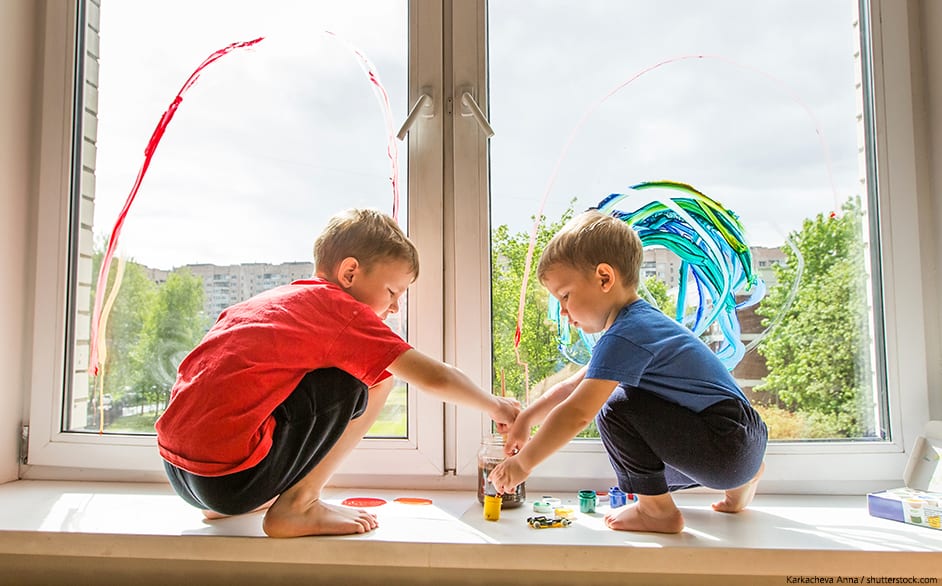
Can Painted Glass be Reused?
It is not that easy to reuse glass that has been previously painted. With the right method, you can do it though. The paint will need to be dissolved with a solvent to completely clean the glass. If you are going to repaint over this, all of the same steps need to be followed as if you were painting a new piece of glass.
Acrylic paint on glass can produce some fascinating effects for all sorts of purposes. Whether you are painting a window, a decorative ornament, or a drinking glass, you can let your creativity run wild and create something very special. Our complete guide on everything you need to know about acrylic paint on glass should have you all prepared and inspired to start your next project.
In 2005, Charlene completed her wellness degrees in therapeutic aromatherapy and reflexology at the International School of Reflexology and Meridian Therapy. She worked for a company offering corporate wellness programs for several years before opening her own therapy practice. In 2015, she was asked by a digital marketer friend to join her company as a content creator, and it was here that she discovered her enthusiasm for writing. Since entering the world of content creation, she has gained a lot of experience over the years writing about various topics such as beauty, health, wellness, travel, crafting, and much more. Due to various circumstances, she had to give up her therapy practice and now works as a freelance writer. Since she is a very creative person and as a balance to writing likes to be active in various areas of art and crafts, the activity at acrylgiessen.com is perfect for her to contribute their knowledge and experience in various creative topics.
Learn more about Charlene Lewis and about us.






